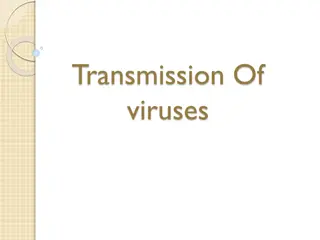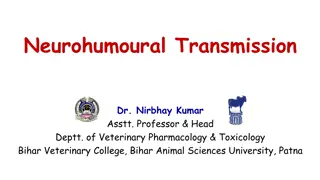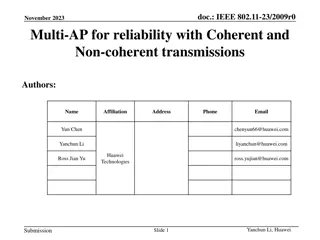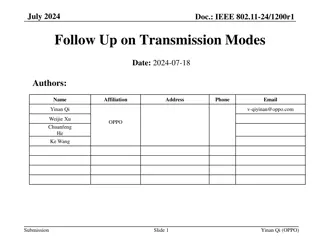Means of Transmission
This session by Dr. Karwan M-Amen explores the means of transmission in infectious diseases, covering topics such as the chain of infection, pathogens, reservoirs, methods of transmission, and susceptible hosts. Understanding these principles is crucial in public health to control the spread of diseases.
Download Presentation

Please find below an Image/Link to download the presentation.
The content on the website is provided AS IS for your information and personal use only. It may not be sold, licensed, or shared on other websites without obtaining consent from the author.If you encounter any issues during the download, it is possible that the publisher has removed the file from their server.
You are allowed to download the files provided on this website for personal or commercial use, subject to the condition that they are used lawfully. All files are the property of their respective owners.
The content on the website is provided AS IS for your information and personal use only. It may not be sold, licensed, or shared on other websites without obtaining consent from the author.
E N D
Presentation Transcript
Means of Transmission Dr. Karwan M-Amen Karwan.m.amen@gmail.com 2019-2020
Learning Outcomes By the end of this session, you will be able to Explain the means of transmission (infectious disease)
Chain of Infection Control of infectious diseases is still an important component of public health. The public health approach to controlling infectious diseases is to interrupt the chain of infection.
The chain of infection, a term used to describe the pattern by which an infectious disease is transmitted from person to person, is composed of several links, as illustrated in next figure.
1. Pathogen: The pathogen is a virus, bacterium, or parasite that causes the disease in humans. 2. Reservoir: The reservoir is a place where the pathogen lives and multiplies. Some pathogens spread directly from one human to another and have no other reservoir. Others, however, may infect nonhuman species, spreading from them to humans only occasionally.
Example Plague, is a disease of rodents that is transmitted to humans by the bite of a flea. Rats are the reservoir of plague. Raccoons and bats are reservoirs for rabies, which spreads to humans only through the bite of a rabid animal. Contaminated water or food may also serve as reservoirs for some human diseases.
3. Method of transmission: The pathogen must have away to travel from one host to another, or from a reservoir to a new host. Example: - Food-borne diseases are transmitted when a person eats contaminated food. - water-borne diseases are transmitted when someone drinks contaminated water. - Many respiratory diseases are transmitted by aerosol. - AIDS, syphilis, gonorrhea, and a number of other diseases are transmitted by sexual contact.
4. Susceptible host: Even if the pathogen gains entry, a new potential host may not be susceptible because the host has immunity to the pathogen. Immunity may develop as a result of previous exposure to the pathogen, or the host may naturally lack susceptibility for a variety of reasons. Most microorganisms are specifically adapted to infect certain species. For example, some viruses do not infect humans. Even within species, susceptibility to specific viruses varies among individuals.
Public health measures to control the spread of disease are aimed at interrupting the chain of infection at whichever links are most vulnerable. At link 1, the pathogen could be killed, for example, by using an antibiotic to destroy the disease-causing bacteria.
At link 2, one could eliminate a reservoir that harbors the pathogen. For example: - Controlling rat populations in cities by picking up garbage is a way of preventing the spread of plague to humans. - Adequate water and sewage treatment prevents the spread of water-borne diseases - Proper food-handling methods eliminate reservoirs of food-borne pathogens.
At link 3, transmission from one host to another could be prevented by: - Quarantining infected individuals. - Warning people to boil their water if the water supply becomes contaminated. - Hand washing is an important way to prevent the spread of disease (e.g., in restaurant, hospital workers) - The spread of sexually transmitted diseases can be prevented by use of a condom.
At link 4, the resistance of hosts can be increased by immunization, which stimulates the body s immune system to recognize the pathogen and to attack it during any future exposure. In some cases, it may even be possible to completely eliminate a pathogen from the earth by eliminating the susceptibility of its potential hosts.
Public health measures to control the spread of infectious disease include both routine prevention measures and emergency measures to control an outbreak once it has begun. Epidemiologic surveillance is the system by which public health practitioners watch for disease threats so that they may step in and break the chain of infection, halting the spread of disease.
In the early history of public health, the solution was often quarantine isolation of the patient to prevent him or her from infecting others. Quarantine is still used occasionally, when the disease is serious and there is no effective vaccine. Example: Ebola virus
Learning Objectives Now, you will be able to Explain the means of transmission (infectious disease)






















